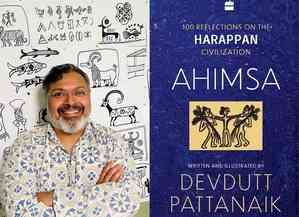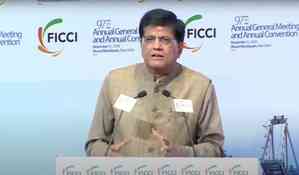Teachings of Jesus are identical with Vedic beliefs' (IANS Interview)
Veteran bureaucrat Harsh Mahaan Cairae is an avid reader and a student of philosophy and religion. He has studied the scriptures of several religions, of which the Vedas have been of special interest. He discovered that the teachings of Jesus Christ are identical with Vedic beliefs.

VISHNU MAKHIJANI
New Delhi, Oct 31 (IANS) Veteran bureaucrat Harsh Mahaan Cairae is an avid reader and a student of philosophy and religion. He has studied the scriptures of several religions, of which the Vedas have been of special interest. He discovered that the teachings of Jesus Christ are identical with Vedic beliefs.
In his book "Discovering Jesus" (Rupa), he proceeds to look for the source of these beliefs reaching Jesus and finds that these were also the original beliefs of the Jews.
"Jesus did not acquire them from an external source. This raises a bigger question of how the beliefs of the Jews were identical with the Vedic beliefs. Were they in any way related to the Aryans? I have relied on a number of literary sources including my earlier book, 'An Aryan Journey' which was a research based on Vedic, Zoroastrian, Greek and Roman literary sources, and concluded that the Jews were Aryans and were of the group which called itself Devs as distinct from Asurs," Cairae told IANS in an interview.
"I, however, concede that this has emerged from literary sources alone and such a big question cannot be answered finally on the basis of one source alone. Other sources of information, particularly genetics need to come in to take the issue to its logical conclusion," he added.
"My first book was based primarily on a research of Vedic and Zoroastrian scriptures in which I had traced the migration route of the Indo-Aryans. In this I had come across a person in Iran, named Mani, who is believed to have been the founder of Manichaeism, a religion very widely practiced till the spread of Christianity. My findings led me to believe that this was the Vedic religion which had acquired a new name as Mani had introduced some reforms. Mani used to claim that he was the Apostle of Jesus Christ. The Manichaens claimed they represented true Christianity, while the Church considered them to be heretics. Heretics, but not followers of some other religion. This led me to believe that there is something wrong in understanding Jesus. Hence the study and the writing (of this book)," Cairae elaborated.
Jesus had twelve main disciples, who were called apostles. One of them, Judas Iscariot, had betrayed him which led to the arrest and crucification of Christ. Judas is reported to have committed suicide thereafter. The remaining apostles, by common consent, nominated another disciple to be an apostle to make the number twelve again. Paul was not one of these. He had never met Jesus in his life, but claimed that he received his teachings in a vision and proclaimed himself an apostle. Christianity today is based on the beliefs and teachings laid down by Paul.
Paul, and later the Pauline Church, created an impression that he and the other apostles preached together and the same things. With this it has got established that what Paul has laid down is what was preached by Jesus.
"Discovering Jesus" brings out evidence to show that Paul and the real apostles were not preaching together or the same things. Paul fought a running battle with them all his life and was not acknowledged as an apostle by their followers. The belief laid down by Paul is that the world would come to an end where after there would be a Day of Judgment. (At places he has said that this could come within the lifetime of the people he was addressing.) When it comes the dead will rise from their graves with new bodies, while the bodies of the living will be transformed. All will be judged for their deeds, the sinners would be sent to suffer in hell till eternity, while the virtuous will go to heaven to enjoy, also till eternity.
"On behalf of God, Jesus would be delivering this judgement. A very important part of this was that whoever believes that Jesus was the Son of God and that he rose from the dead would go to heaven. Thus, faith alone, in his doctrine, was sufficient. The book asserts that Jesus and his apostles did not have any such belief and did not preach this. They believed in the transmigration of souls in which a person was born in a position on the basis of his deeds in the previous life. The soul could go out of the cycle of rebirth and attain salvation by realising the true nature of the self. The teachings of Jesus were thus diametrically opposite to what Christians believe today and as were laid down by Paul.
In showing that Paul was fighting with the apostles and not preaching with them, the book first brings out evidence from the Bible itself. The letters of Paul, that are a part of the New Testament and are called Epistles, show the discord. Very important are the quotes from the Epistle to the Hebrews. The book brings out that this is addressed by Paul to the apostles. In this Paul has listed out the doctrinal differences that he had with them and has requested them to leave them aside for the present for a discussion in the future and for the time being discontinue animal sacrifice. The doctrinal differences he records include the debate between deeds and faith; doctrine of baptism; laying on of hand; resurrection of the dead; and eternal judgement.
These are fundamental beliefs of Christianity today, which Paul has himself recorded, were issues on which the Apostles did not agree with him. For animal sacrifice, which Paul was requesting to be stopped immediately, the book brings out evidence to show that this was practiced in the Church.
Apart from what emerges from the Bible, the book brings out evidence from the writings of the Christian Fathers of the early centuries to show that the followers of the apostles did not acknowledge Paul as an apostle and did not believe in what he preached. James, an apostle and the brother of Jesus, had become the bishop of Jerusalem and the head of the Church of the apostles after the death of Jesus. No writings of anyone from this side have survived. All that has come down to us is from Pauline traditions, except a set of gnostic literature that was found in the last century, carefully packed and buried in Egypt and goes by the name of the Nag Hammadi Library.
The care with which it was found packed shows that there was a danger of it being destroyed by the opponents, which the keepers were in no position to resist.
Despite nothing coming from the apostolic side, a lot about them can be known from the Pauline writers as a lot of them have written about them and their beliefs, at times for repudiation and at others to mock. Based on this, the book brings out evidence to show that Paul was considered to be an apostate by the followers of the apostles.
Having shown that Paul was not on the same side as the apostles, the book proceeds to bring out the myths that Paul and the Pauline Church created to support their belief system and for that how the New Testament was tampered with. It shows that only the Gospel of Mathew was the genuine gospel accepted by the followers of the apostles and, as it was in Hebrew, the Gospel of Mark was its translation into Greek. The rest of the New Testament is Pauline. Even in these two a lot of interpolations have been made to support Pauline theology. To create a divine stature for Jesus, myths have been created of his birth from a virgin, miracles performed by him and his rising from the dead. The last myth has been created also to support the theory of the resurrection of the dead on the Day of Judgment. The book brings out evidence to show that the apostles and their followers did not believe in any of these myths.
For the concept of the Immaculate Conception, apart from bringing out evidence to show that the apostles did not believe in it, the book points out that it cannot be believed because Joseph and Mary, the parents of Jesus did not believe in his divinity. If it had been true, they would have been the direct witnesses to the event and would have received the testimony of the Holy Spirit that Jesus was the Son of God. In such a situation they should have been the first and foremost believers of his divinity and should have been his followers.
The Bible does not mention Joseph after the childhood of Jesus while references to Mary show that she was not a believer. The book states that we have a situation wherein the Church wants its followers to believe that Jesus was the Son of God while the mother who gave him birth did not believe in this. The book also notes that this myth was not created by Paul but emerged a few centuries later. Paul does not mention this anywhere in his extensive writings. The basis for saying that this was incorporated later is the reason for the creation of this myth.
It is claimed that this was to fulfill a prophecy. Christians believe that the Old Testament, which is the Tanakh, the scripture of the Jews, contains prophecies about the coming of Christ and Jesus, by his birth and life, fulfilled all of them. Starting the story of the birth of Jesus, the Gospel of Mathew states, 'Now all this was done, that it might be fulfilled which was spoken of the Lord by the prophet, saying Behold, a virgin shall be with child, and shall bring forth a son.' This was a reference to what was stated by Isaiah in the Old Testament.
The Jews had pointed out that there was no such prophecy and that there was an error in the translation wherein the word meaning 'young girl' has been translated as 'virgin'. This error had occurred in the translation from Hebrew to Greek that the Egyptian Pharoah Ptolemy had got done for his library in Alexandria and is called the Septugint Version. All later translations are from this. The book has pointed out that the author of this story had no access to the Hebrew version, which shows that it was crafted much later.
So far as the myths relating to the miracles performed by Jesus are concerned, the book has stated that the possibility of such things happening is a matter of faith and has not commented on it. However, it has examined certain related issues as they emerge from the narrative of the Bible. One is that they did not have any effect on the people before whom they are said to have been performed. Jesus is reported to have brought back to life a number of persons who had died. A person performing such a deed should normally attract the veneration of everyone who gets to know of it. This is not reflected in the narrative of the Bible.
At one stage Jesus was left with only his twelve disciples as all the rest had left him. Even amongst these twelve one betrayed him. The second is that what has been reported along with the miracles does not match with the known historical position of the area. In one case when Jesus brought back to life a dead person, the Jews are reported to have conferred and felt that if he is allowed to do such things, the Romans would be attracted and subjugate the area. This is against the known history as the area was already a part of the Roman Empire, which shows that someone unacquainted has interpolated the story.
The third myth created by the Pauline Church was that Jesus rose from the dead and appeared to his disciples with his physical body. The book brings out the contradictions in the reporting of his appearance in different gospels and elsewhere in the Bible. It has also stated that people for centuries have tried unsuccessfully to reconcile these contradictions. Having examined the contradictions, the book proceeds to examine the evidence that shows that the apostles and their followers did not believe in this. In the Bible this emerges clearly from the Epistle to the Hebrews. The points of differences enumerated by Paul for future discussion includes this. In the writings of the Church Fathers this emerges at a very large number of places. They have categorically stated that the followers of the apostles did not believe that Jesus rose from the dead.
The book next proceeds to examine how Paul and the Pauline teachings acquired apostolic authority. This was done by weaving stories around Paul and by showing that he and the other apostles, particularly Peter, were preaching together and the same things. To raise the stature of Paul to the level of an apostle, three things have been done, an extraordinary situation of his conversion to Christianity has been created, he has been shown performing miracles and finally to have been martyred for his faith.
In the Bible, the Acts of the Apostles speaks much of this. Paul has been stated to have been an ardent Jew who was persecuting the Christians. Having done so in Jerusalem he is reported to have sought the permission of the High Priest of the Temple to bind all the Christians in Damascus and bring them over to Jerusalem to be punished. As he was reaching Damascus he had a vision of Jesus who asked him why he was persecuting his followers. Paul became blind at that moment. As he developed faith he was told to meet a certain Christian in Damascus and his sight would be restored.
This story has been repeated at several places by Paul wherein he has contradicted himself. What he heard from Jesus has changed in different narratives and what he did after becoming a Christian is different at different places. At one place he has stated that he went to Jerusalem to meet the other apostles and at another, to Arabia to preach and returned after a few years to meet the apostles. The book has examined these contradictions and shown that this story is false. It has also stated that neither the High Priest of the Temple had the authority to authorise Paul to bind and bring the Christians from Damascus to Jerusalem to be punished nor did Paul have the capacity to do so even if there were Christians in Damascus at that early stage, though it is very unlikely.
Paul was a tentmaker from Tarsus, which falls in modern Turkey. He was neither a military commander nor a brigand. At that time the Roman Empire and the Parthian Empire were vying for control of Syria and Damascus was most likely a part of the Parthian Empire. Paul could not have bound anyone there and brought him to Jerusalem even if he was armed with a letter from the High Priest. The story of his conversion to Christianity is only to create an aura around him.
Paul has been reported in the Bible to have performed miracles, including bringing to life a dead person. This too has been done with the same purpose and cannot be true as at other places in his writings he and his close disciple have been reported to be very sick. He doesn't cure himself or his disciple by the touch of his hand. Instead he advises his disciple to have some wine.
The third myth created to raise the stature of Paul is of his martyrdom. In Christianity martyrdom for the religion is considered to be the highest act of faith. The Bible weaves a long story of Paul being arrested in Jerusalem and taken to Rome but concludes abruptly without saying what happened to him. At another place Paul writes that he is prepared to be offered, but the Bible does not state when and where Paul was killed. The Church has developed a myth that he and Peter were martyred on the same day under the orders of the Emperor Nero, Paul by being beheaded and Peter by being crucified with his feet up.
The book has examined this point at length and found that Roman persecution of the Christians was not on religious grounds but because the Church had pushed its followers to the path of sedition. This persecution was limited to the followers of the Pauline Church. The followers of the apostles were not persecuted. In fact one of them with the name Simon Magus was honoured with a statue by the predecessor of Nero. The Pauline Church gained grounds much later because of which it can be said that the persecution of Christians had not begun in Nero's time. The story of the execution of Paul and Peter is hence false. For Peter it has also been claimed that he was the first bishop of Rome. The book brings out evidence to show that this is not true.
The book proceeds to examine how the Pauline Church took over and what happened to the Church of the apostles. In this it finds that there was no external taking over of the apostolic Church by the Pauline Church, but that the Pauline theology gradually crept into the apostolic Church and obliterated the apostolic theology. Paul's writings became a part of the Christian scriptures. Paul had written extensively while the apostles wrote hardly anything. Their teachings were recorded by their disciples. Once Paul's writings became a part of the Bible and Paul acquired apostolic authority, wherever the teachings of the apostles came in conflict with what had been written by Paul, they were declared to be heresies propounded by the disciples of the apostles who had recorded them.
This happened first in the Western Church with Rome as the focal point as Paul's writings were in the west. The process in the West went almost unnoticed. In the Eastern Church, with Constantinople as the focal point, Paul's writings reached a few centuries later, by when the apostolic teachings were more firmly entrenched. A new element of the Emperor Constantine interfering to have a common faith of all Christian, also came in. Because of this there was a lot of acrimony in the East which finally led to the division of the Eastern and the Western Church. It began with the Council of Nicene in which Constantine almost forced the Eastern Church to accept what was believed by the West. The beliefs of the East were declared to be heresies. As this did not succeed fully several more councils were held. All along, however, Pauline theology was creeping into the East also and over a period of time it wiped out almost all of the apostolic teachings.
The book proceeds next to look for the teachings of Jesus and the apostles. Information about them has been culled out from Pauline literature as that alone has survived. In this the followers of the apostles have been branded as heretics. The Gnostics in the east were also considered to be outside the pale of Pauline beliefs. In such a situation what have been reported to have been the beliefs of the heretics and the Gnostics have to be the teachings of Jesus. As these have come from their opponents, who have mentioned them only to show how hollow these beliefs were, they emerge in a very disjointed manner. These beliefs were, however, identical to the Vedic beliefs because of which the book has placed them side by side with the Vedic beliefs. This has been done so that they could be understood in their entirety and not in bits and pieces. Six fundamental elements of the Vedic beliefs have been found in the beliefs of the apostles and have been compared. These are:
* The religion had two distinct streams, one for common believers and the other for the spiritually inclined. The practices of the latter were the core of the religion.
* Secrecy was maintained of the core teachings.
*The belief that there was no difference between the Creator and the creation. The unbridgeable gap between God and man was not there.
*There was a belief in the rebirth of the soul in which the next birth was determined by the deeds of the previous birth. It was possible for the soul to go out of this cycle of births and deaths and attain salvation.
* The objective of a practitioner was to go out of the cycle of births and deaths and attain salvation. This is achieved by the realization that I and God are the same. I do not exist only He does.
*There were two philosophical thoughts prevalent, one the dualism of Sankhya and the other the non dualism of Vedant.
The book brings out evidence to show that all these elements were present in the beliefs of the Christians declared heretics and Gnostics by the Pauline Church.
"Discovering Jesus" is a groundbreaking work that needs to be read with an open mind.
(Vishnu Makhijani can be reached at [email protected])


 IANS
IANS 












